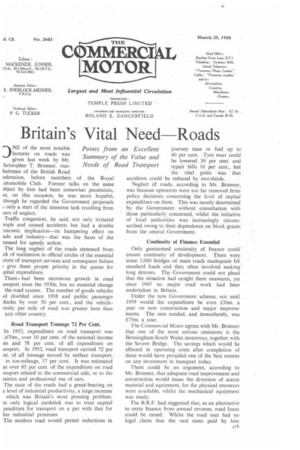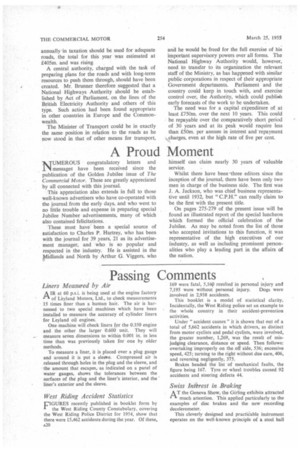Britain's Vital Need Roads
Page 21

Page 22

If you've noticed an error in this article please click here to report it so we can fix it.
3 NE of the most notable lectures on roads was given last week by Mr. !hristopher T. Brunner, vicehairman of the British Road ederation, before members of the Royal ,utomobile Club. Former talks on the same ibject by him had been somewhat pessimistic, ut, on this occasion, he was more hopeful, [though he regarded the Government proposals ; only a start of the immense task resulting from :ars of neglect.
Traffic congestion, he said, not only irritated :ople and caused accidents but had a double ;onomic implication—its hampering effect on ade and industry—that was the basis of the :mand for speedy action.
The long neglect of the roads stemmed from ck of realization in official circles of the essential iture of transport services and consequent failure ■ give them proper priority in the queue for ipital expenditure.
There. had been enormous growth in road ansport since the 1930s, but no material change the road system. The number of goods vehicles id doubled since 1938 and public passenger !hides by over 50 per cent., and the vehicle:nsity per mile of road was greater here than any other country.
Road Transport Tonnage 72 Per Cent.
In 1953, expenditure on road transport was .,670m., over 10 per cent. of the national income en and 78 per cent. of all expenditure on insport. In 1952, road transport carried 72 per nt. of all tonnage moved by surface transport,. in ton-mileage, 37 per cent. It was estimated at over 85 per cent, of the expenditure on road insport related to the commercial side, or to the isiness and professional use of cars.
The state of the roads had a great bearing on e level of industrial productivity, a large increase which was Britain's most pressing problem. le only logical yardstick was to treat capital penditure for transport on a par with that for her industrial processes The modern road would permit reductions in journey time or fuel up to 40 per cent. Tyre wear could be lowered 30 per cent. and repair bills 10 per cent., but the vital point was that accidents could be reduced by two-thirds.
Neglect of roads, according to Mr. Brunner, was because operators were too far removed from policy decisions concerning the level of capital expenditure on them. This was mostly determined by the Government without consultation with those particularly concerned, whilst the initiative of local authorities was increasingly circumscribed owing to their dependence on block grants from the central Government.
Continuity of Finance Essential Only guaranteed continuity of finance could ensure continuity of development. There were some 3,000 bridges on main roads inadequate for standard loads and they often involved making long detours, The Government could not plead that the situation had caught them unawares, yet since 1945 no major road work had been undertaken in Britain, Under the new Government scheme, not until 1959 would the expenditure be even £50m. a year on new construction and major improvements. The sum needed, and immediately, was £75m. a year.
The Commercial Motor agrees with Mr. Brunner that one of the most serious omissions is the Birmingham/South Wales motorway, together with the Severn Bridge. The savings which would be effected in operating costs after completion of these would have proyided one of the best returns on any investment in transport today.
There could be no argument, according to Mr. Brunner, that adequate road improvement and construction would mean the diversion of scarce material and equipment. for the physical resources were available, whilst the mechanical equipment was ready.
The B.R.F. had suggested that, as an alternative to extra finance from annual revenue, road loans could be raised. Whilst the road user had no legal claim that the vast sums paid by him annually in taxation should be used for adequate roads, the total for this year was estimated at £405m. and was rising A central authority, charged with the task of preparing plans for the roads and with long-term resources to push them through, should have been created. Mr. Brunner therefore suggested that a National Highways Authority should be established by Act of Parliament, on the lines of the British Electricity Authority and others of this type. Such action had been found appropriate in other countries in Europe and the Commonwealth.
The Minister of Transport could be in exactly the same position in relation to the roads as he now stood in that of other means for transport, and he would be freed for the full exercise of his important supervisory powers over all forms. The National Highway Authority would, however, need to transfer to its organization the relevant staff of the Ministry, as has happened with similar public corporations in respect of their appropriate Government departments. Parliament and the country could keep in touch with, and exercise control over, the Authority, which could publish early forecasts of the work to be undertaken.
The need was for a capital expenditure of at least £750m. over the next 10 years. This could be repayable over the comparatively short period of 30 years and at its peak would require less than £50m. per annum in interest and repayment _charges, even at the high rate of five per cent.
























































































